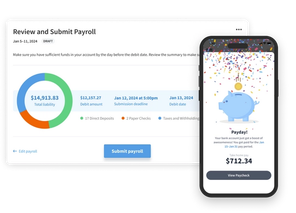
Eddy’s HR Mavericks Encyclopedia
The world's largest free encyclopedia of HR, with 700+ HR articles and podcasts.
Created by Eddy and our HR Mavericks community.
Lump-Sum PTO Policy
Are you facing challenges administering all the different kinds of paid time off: sick, vacation, holidays, flex time, and more? Lump-sum PTO can streamline administration and improve employee morale.
What Is a Lump-Sum PTO Policy?
Lump-sum paid time off (PTO), also known as a PTO bank, is when an organization provides its employees a set number of paid time off days per year—typically at once—that either rolls over from year to year or expires at the end of the year. This bank of hours may cover all the most common types of leave, such as sick days, vacation, holidays, and more, depending on your policy.
Should Companies Offer Lump-Sum PTO?
Deciding to use a lump-sum PTO policy is contingent upon several factors; however, one of the most important is whether your employee satisfaction will be negatively or positively impacted, which can ultimately impact your organization’s bottom line. Consider the following when deciding whether your organization should adopt a lump-sum PTO strategy.
- Consider the needs of your teams. Lump-sum PTO may work perfectly for one team but not for the others.
- Look at your industry and what your competitors are doing/offering.
- Review your current policy.
- Consider surveying your employees as to their preference.
Pros of Offering a Lump-Sum PTO Policy
Paid time off is an important benefit for your employees, and as with any benefit offerings, there are pros and cons. Let's first examine the pros of offering lump-sum PTO.
- Provides privacy. Unlike sick time, this type of PTO allows employees to take time off without noting what the time requested is for.
- Ease of administration. Lump-sum PTO is less challenging to administer, as there’s only one balance to track.
- Cost. Because administration time is drastically reduced, lump-sum PTO is more cost-efficient.
- Employees may like it because it provides flexibility; they can use the time as they see fit.
Cons of Offering Lump-Sum PTO
Lump-sum PTO does have its disadvantages.
- Separation. Employees who are resigning or retiring are motivated to use their PTO before they go; they could leave responsibilities unfulfilled.
- Employees may not like it because PTO can be viewed as using vacation time when they are sick.
How Does Lump-Sum PTO Work?
Lump-sum PTO is one of the most commonly used PTO strategies. A 2021 survey on paid leave found that 44% of organizations surveyed used a lump-sum PTO strategy. How it works depends on your organization’s policies.
Step 1: Decision
Deciding on which PTO strategy to use is contingent upon a number of factors. Consider why your organization would adopt a lump-sum PTO practice. Are you attempting to increase flexibility, ease the administration process, reduce absenteeism, or improve employee morale? These are all incentives as to why one would consider such a strategy.
Step 2: Days/Hours Allotted
Normally this type of time off combines all the days that your organization would normally provide employees in one lump sum. For example, holidays, vacation, sick, flex days are pooled together.
Step 3: Years of Service
Many organizations design the hours/days offered based on the employee’s years of service or position. For example, a more senior level employee such as the organization’s chief financial officer may receive 40 additional hours in their PTO bank as compared to newer or less demanding positions.
Step 4: Administration
Be sure to consider how you will administer your policy. One of the most important factors to consider is how generous your organization will be. Will employees be able to carry over days/hours and if so, how much? By tracking the available and used time, you are able to reduce workplace disruptions and avoid any decrease in production. You can track lump sum PTO by paper, spreadsheets, or a human capital management system such as Eddy.
Best Practices for Companies Offering Lump-Sum PTO
A great lump-sum PTO policy is beneficial to both the employee and the employer, and to ensure this, you’ll want to follow a few best practices.
Attractive
Be sure that your lump-sum PTO strategy is attractive. For example, the strategy should allow employees to use it for various reasons, such as non-organizationally-recognized holidays or mental health.
Clarity
Make sure your employees clearly understand your policy and its boundaries. Present it in a variety of ways throughout the year.
Legal
Though there are no federal mandates, if your policy allows for employees to use PTO for sick leave, be sure to identify and comply with any applicable state and local jurisdictions. Here is one resource for locating paid sick leave requirements by both state and municipality.
Use PTO
It is a best practice to encourage your employees to use their PTO. Often, employees feel guilty about requesting time off, so make sure leadership models taking PTO and express the importance of work/life balance.
Topics

Wendy N. Kelly, MSHRM, PHR, SHRM-CP
Wendy is an HR professional with over 10 years of HR experience in education and health care, both in the private and non-profit sector. She is the owner of KHRServices, a full service HR management agency. She is also SHRM and HRCI certified, serves as a HRCI Ambassador, and voted 2021 Most Inclusive HR Influencer.
Frequently asked questions
Other Related Terms
Eddy’s HR Mavericks Encyclopedia
Lump-Sum PTO Policy
Are you facing challenges administering all the different kinds of paid time off: sick, vacation, holidays, flex time, and more? Lump-sum PTO can streamline administration and improve employee morale.
What Is a Lump-Sum PTO Policy?
Lump-sum paid time off (PTO), also known as a PTO bank, is when an organization provides its employees a set number of paid time off days per year—typically at once—that either rolls over from year to year or expires at the end of the year. This bank of hours may cover all the most common types of leave, such as sick days, vacation, holidays, and more, depending on your policy.
Should Companies Offer Lump-Sum PTO?
Deciding to use a lump-sum PTO policy is contingent upon several factors; however, one of the most important is whether your employee satisfaction will be negatively or positively impacted, which can ultimately impact your organization’s bottom line. Consider the following when deciding whether your organization should adopt a lump-sum PTO strategy.
- Consider the needs of your teams. Lump-sum PTO may work perfectly for one team but not for the others.
- Look at your industry and what your competitors are doing/offering.
- Review your current policy.
- Consider surveying your employees as to their preference.
Pros of Offering a Lump-Sum PTO Policy
Paid time off is an important benefit for your employees, and as with any benefit offerings, there are pros and cons. Let's first examine the pros of offering lump-sum PTO.
- Provides privacy. Unlike sick time, this type of PTO allows employees to take time off without noting what the time requested is for.
- Ease of administration. Lump-sum PTO is less challenging to administer, as there’s only one balance to track.
- Cost. Because administration time is drastically reduced, lump-sum PTO is more cost-efficient.
- Employees may like it because it provides flexibility; they can use the time as they see fit.
Cons of Offering Lump-Sum PTO
Lump-sum PTO does have its disadvantages.
- Separation. Employees who are resigning or retiring are motivated to use their PTO before they go; they could leave responsibilities unfulfilled.
- Employees may not like it because PTO can be viewed as using vacation time when they are sick.
How Does Lump-Sum PTO Work?
Lump-sum PTO is one of the most commonly used PTO strategies. A 2021 survey on paid leave found that 44% of organizations surveyed used a lump-sum PTO strategy. How it works depends on your organization’s policies.
Step 1: Decision
Deciding on which PTO strategy to use is contingent upon a number of factors. Consider why your organization would adopt a lump-sum PTO practice. Are you attempting to increase flexibility, ease the administration process, reduce absenteeism, or improve employee morale? These are all incentives as to why one would consider such a strategy.
Step 2: Days/Hours Allotted
Normally this type of time off combines all the days that your organization would normally provide employees in one lump sum. For example, holidays, vacation, sick, flex days are pooled together.
Step 3: Years of Service
Many organizations design the hours/days offered based on the employee’s years of service or position. For example, a more senior level employee such as the organization’s chief financial officer may receive 40 additional hours in their PTO bank as compared to newer or less demanding positions.
Step 4: Administration
Be sure to consider how you will administer your policy. One of the most important factors to consider is how generous your organization will be. Will employees be able to carry over days/hours and if so, how much? By tracking the available and used time, you are able to reduce workplace disruptions and avoid any decrease in production. You can track lump sum PTO by paper, spreadsheets, or a human capital management system such as Eddy.
Best Practices for Companies Offering Lump-Sum PTO
A great lump-sum PTO policy is beneficial to both the employee and the employer, and to ensure this, you’ll want to follow a few best practices.
Attractive
Be sure that your lump-sum PTO strategy is attractive. For example, the strategy should allow employees to use it for various reasons, such as non-organizationally-recognized holidays or mental health.
Clarity
Make sure your employees clearly understand your policy and its boundaries. Present it in a variety of ways throughout the year.
Legal
Though there are no federal mandates, if your policy allows for employees to use PTO for sick leave, be sure to identify and comply with any applicable state and local jurisdictions. Here is one resource for locating paid sick leave requirements by both state and municipality.
Use PTO
It is a best practice to encourage your employees to use their PTO. Often, employees feel guilty about requesting time off, so make sure leadership models taking PTO and express the importance of work/life balance.
Topics

Wendy N. Kelly, MSHRM, PHR, SHRM-CP
Wendy is an HR professional with over 10 years of HR experience in education and health care, both in the private and non-profit sector. She is the owner of KHRServices, a full service HR management agency. She is also SHRM and HRCI certified, serves as a HRCI Ambassador, and voted 2021 Most Inclusive HR Influencer.
Frequently asked questions
Other Related Terms
Eddy's HR Newsletter
Sign up for our email newsletter for helpful HR advice and ideas.


